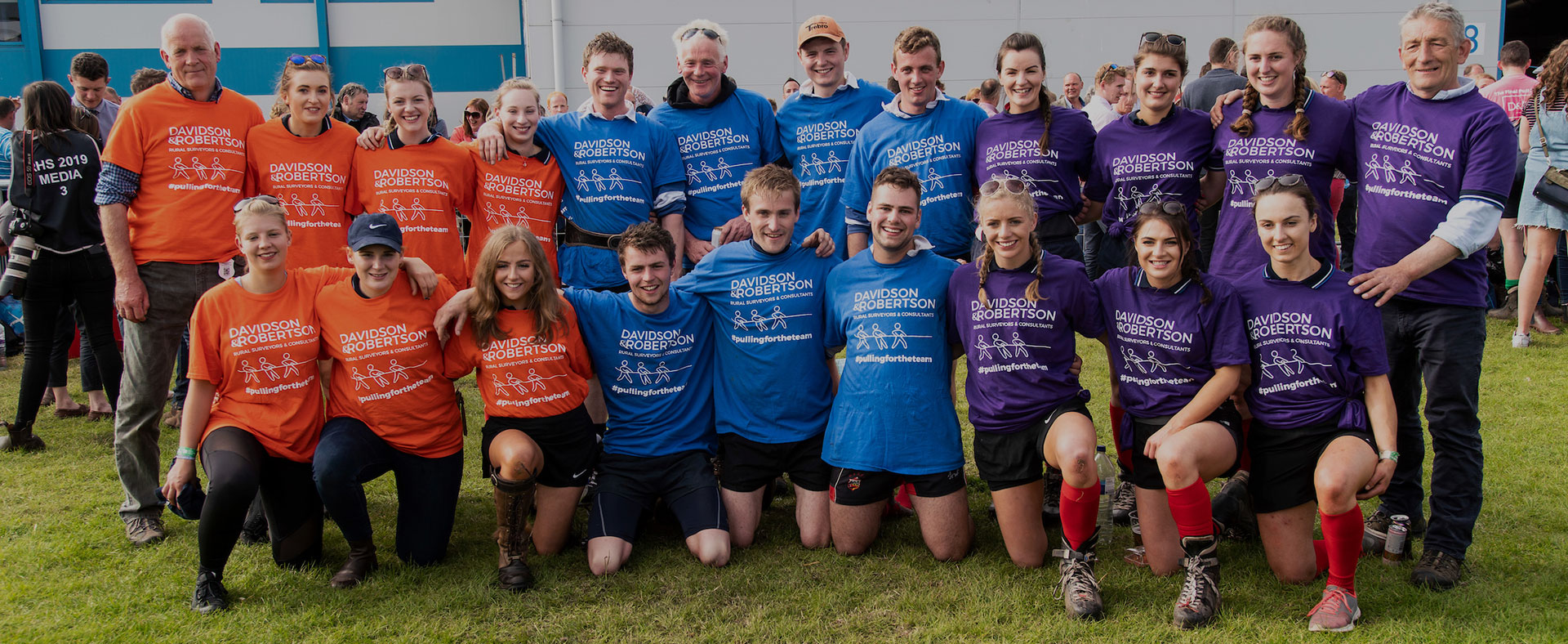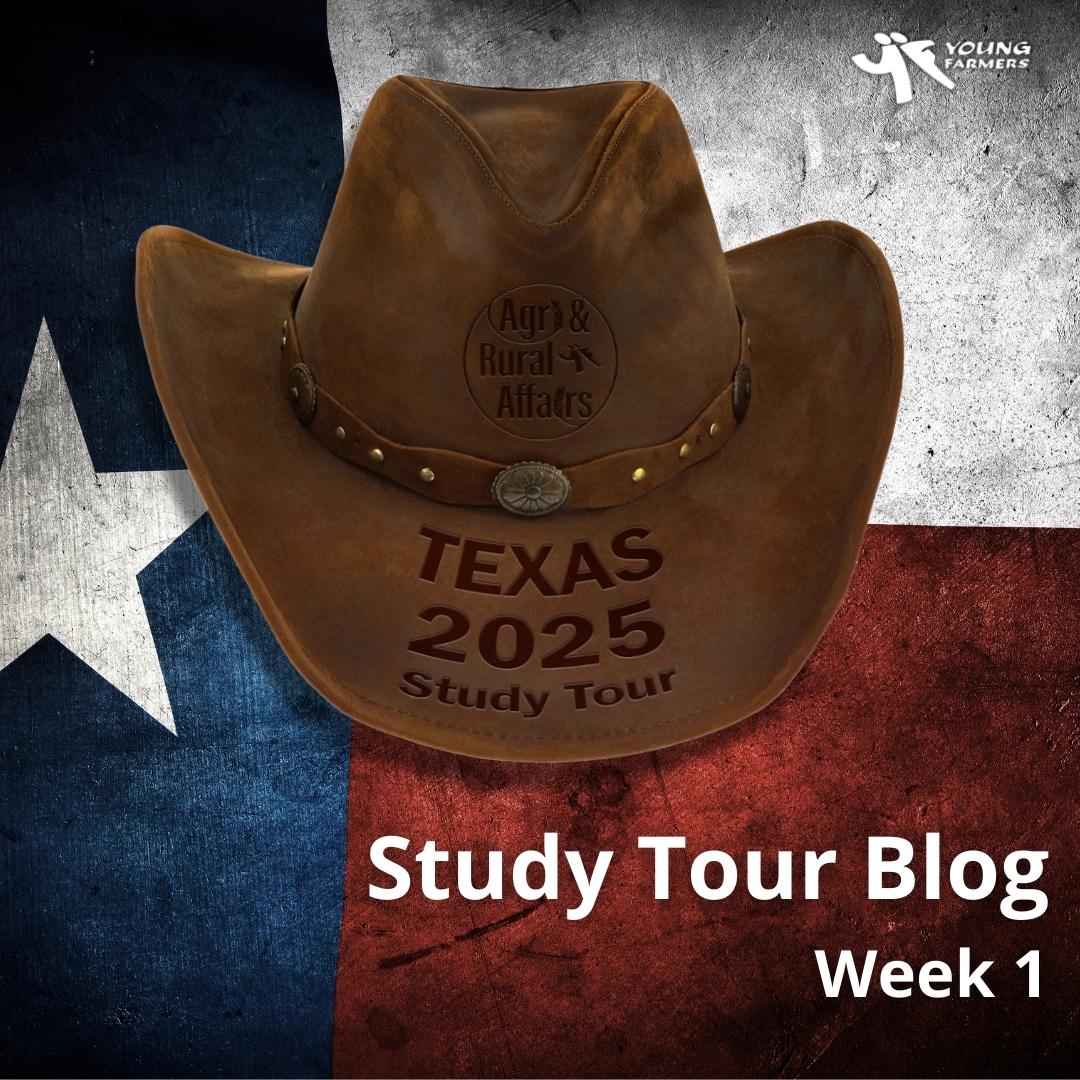
19 Nov Texas Study Tour Week 1

We kicked off our first full day in Austin with a group tour of the Capitol building from Patrick Dudley, husband of Dr Jean Dudley from the state university of agriculture who has been the key contact in the planning of the whole trip. Patrick used to work in the Capitol building in the Texas Department of Agriculture, his role is communicating with the state administered levy boards which cover 12 different commodities. Several of the key commodities are levied by federal boards like eggs, sorghum and dairy.
The Capitol building of Texas was built in the 1880s by a large number of Scottish stonemasons, it had an underground extension in the 1990s creating 2 floors underground and 2 floors of car-parking. The magnificent building housed both the Senate and the larger House of Representatives. Patrick gave us a great overview of both the history and the operation of the state politics. The Battle of the Alamo has been an influential point in the history of the state and it’s relations with Mexico, it’s neighbour. The Texan goddess of liberty faces south, towards Mexico unlike all other US Capitol buildings which face North. Patrick did emphasis the Texan approach to being different from other US states on multiple things.
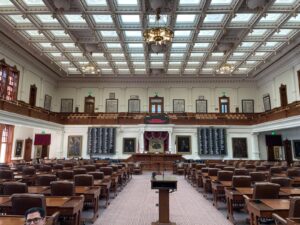
The timing of this meeting was useful to gain a business insight into the current state of the different farming sectors in Texas, similar to the UK, beef is resilient and Joe alluded to a lot of recent lending towards herd expansions off the back of this. Cotton is a large commodity in Texas and we passed a few mills and farms on the way to Tyler, they are currently experiencing a depression based around market pressures from Asia due to Trumps tariffs, however good yields have been keeping the afloat.

We presented Joe and Tyler with a token of our appreciation and they were delighted to host us in Tyler, which Joe was very proud to call his hometown.
James Hay
Day 2 – A Day with Texas Forestry Association and Dinner with Texas Dairy Association
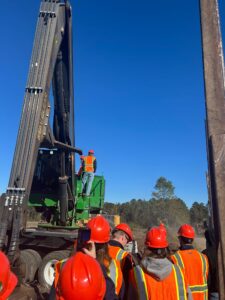
We spent the day with Rob Hughes from the Texas Forestry Association, who gave us a fantastic insight into forestry here in the Lone Star State. Rob and his team took us out to a plantation where we met Lauren, Caleb, and the foresters, and got to see the whole operation in action from trees being cut using impressive machinery to being loaded onto lorries. The boys were very much in their element…
We then visited another part of the forest where young trees were being planted fascinating to watch as each seedling was carefully placed in the ground using specialised equipment and a clever trailer setup.

Next, we toured a mill production site, following the full process from the moment the lumber arrives from the forest to when it’s manufactured into a range of products. It was amazing to see how it all ties together, a truly efficient and sustainable system.
To give you an idea of scale, Texas has over 12 million acres of forestry, with around 95% used in-state and only 5% exported, mainly for the construction industry. Rob’s knowledge, passion, and enthusiasm were infectious, and we all came away with a much deeper appreciation for the forestry sector in Texas.
After a great day in the woods, we joined Rob for a few well-earned drinks back at the hotel bar before heading out to dinner with the Texas Dairy Association. It was a fantastic evening of Texan cuisine and great conversation with local dairy farmers, some milking over 30,000 cows, which blew our minds!

A brilliant first full day in Texas — and we can’t wait to see what else is in store for the rest of the trip!
Emily Black
Day 3 – The Chicken Industry and Cavenders Cowboy Clothing.
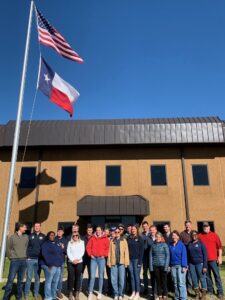
We headed off early to Wayne Sanderson farms, one of Texas’s biggest chicken growers and producers, with farms from rearing, egg production, boilers and breeding. Having to sign our non-disclosure forms on the bus, we were eager to see what we were going to see, unaware we were actually going to visit one of the largest chicken killing and processing plants in the state.
Arriving at the site, we were met with truck loads of empty crates leaving and a que of white broiler hens entering the site, the scale was also displayed by the size of the staff car park with hundreds of cars parked in front of the main building.
We disembarked the bus and headed through security to meet our host Jackie, head of operation at the plant and she was also joined by JC Essler, executive vice president from the Texas chicken association.
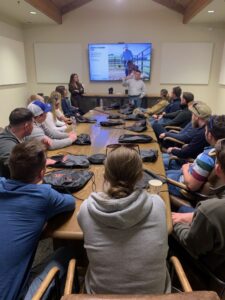
After an introduction and welcome we kitted ourselves out in safety gear and split down into groups to head into the plant. What followed was a tour of the production line that can process 265,000 chickens a day, from live hens coming in to being packed and chilled in around 2 and a half hours. The scale and size of the plant was overwhelming, with a maze of elevators and conveyers taking different cuts to areas to be packed or processed. Although the mechanic scale was impressive, the size of workforce was also surprisingly large with 1800 staff working over 3 shifts 5 days a week.
With ear protection in and the noise of the plant, it was a quicker tour round with questions having to be kept for after but the sheer scale and speed was very impressive. The cleanliness of the plant was also noticed and several times we observed quality control being carried out, ensure a very high quality, consistent product was being produced.
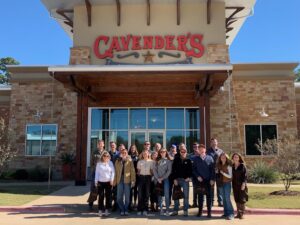
The final part of the walking tour maybe brought home the scale of the factory though, where we got to walk down to the live hens coming in and being hung on to the line to be then dipped in water and stunned before being killed. This part of the process was swift and efficient, on such a scale though that kept high welfare standards. When later asked about animal protesters and vegans, JC commented that they do everything to the highest standards and correctly but at the end of the day “killing chicken is killing chicken”.
Once the walking tour finished we had a chance to talk with our hosts and some of the plant working and had a great selection of questions. Running operations was discussed and the monumental amount of water the plant uses was covered, with close to 7.2 million litres of water used every day in the plant, this is then all cleaned through an onsite treatment plant and then irrigated on hay pasture to return into the ground.
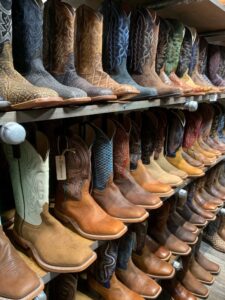
After a stop for a bbq brisket lunch we headed to the headquarters of Cavenders, an original Texas family owned western work wear clothing shop. After a tour round the offices and meeting several staff we got the chance to visit their flagship store in town, where the group then all started to embrace the cowboy culture and purchase boots, hats and shining belt buckles.
Cameron Smith
Day 4- Texas Agriculture Introduction Session and St Genetics Visit
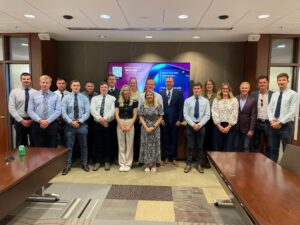
They described the enormous scale of Texas agriculture, noting that if the state were its own country, their economy would rank sixth in the world. Oil remains the largest sector, closely followed by agriculture. Around 95% of Texas land is privately owned, which shapes both production patterns and the policy environment. Texas leads the nation in beef, cotton, and grapefruit production and ranks within the top five for poultry and dairy. As Mr. Hunter noted, Texas is always harvesting something, with the citrus season currently underway.
The discussion also highlighted the thriving specialty product sectors. Texas has roughly 550 vineyards, including six wines ranked among the top 100 worldwide, and around 250 distilleries, one of which an Austin rum has been recognised as the most popular in Japan. These industries demonstrate the diversification and increasing international competitiveness of Texas agriculture.

The COVID-19 pandemic brought renewed focus to food security while deepening the disconnection between consumers and agricultural production. The agricultural trade deficit is widening as land is lost to urbanisation, drought, and alternative land uses that provide higher financial returns than farming. Despite its strong production base, the United States is now a net importer of food, raising long term questions about resilience and food independence.
Energy and environmental policy add new layers of complexity. Solar developments supported by feed-in tariffs can make non-agricultural land uses more financially attractive than farming. Climate change continues to drive uncertainty and the need for ongoing adaptation, supported by certification frameworks and resilience programmes. Levies charged are reinvested into young farmer initiatives, and government backed insurance remains crucial to managing risk. Disease challenges, including avian influenza and its potential implications for cattle, demand constant monitoring.
Further insight was provided through Texas A&M AgriLife Extension from Mr. Rick Avery and Mr. Cliff Lamb. Research funding for 2024 stands at around $345 million. With between 1,300 and 1,500 new residents arriving in Texas every day, pressure on land, infrastructure, and natural resources is immense. Agriculture contributes roughly $240 billion to the Texas economy, accounting for around 9.3% of GDP.
Wildlife issues were highlighted as a major concern. The threat of the screwworm parasite pose risks, but the greatest challenge is the rapidly expanding wild hog population. The damage to crops, ecosystems, and infrastructure is severe. As Mr. Lamb remarked “We can’t barbecue our way out of this problem” capturing even aggressive control programmes barely make a dent in a population that can triple within a year.
In their final remarks, Mr. Hunter and Dr. Butler returned to two key themes. First, they emphasised the remarked that the face of agriculture is changing, with more women than ever involved in production, science, business, and policy, reflecting a more modern and representative industry. Second, they reminded us that although they could offer insight and policy context, the greatest learning comes from our peers. It was a fitting conclusion to a meeting that highlighted both the challenges and the opportunities within Texan agriculture today.
Katie Forster
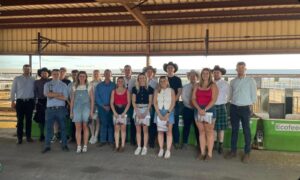
ST Genetics is a global leader in cattle genetics and reproductive technologies, The company employs approximately 250 staff members at their Texas base and operates in 22 locations worldwide, including through its international partnership with Cogent.
They work across a Total Site Area of 1,700 acres and forage is grown and transported from another site to feed the cattle.
Their cutting edge Embryo Transfer & IVF Centre Provides reproductive services for both internal use and external clients. The Research Centre is designated to monitoring feed intake and methane emissions.
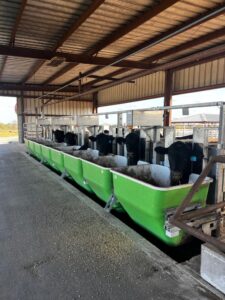
Livestock and Breeding Operations
ST Genetics maintains its own breeding herds for both beef and dairy.
Total Bulls:
- 285 beef bulls
- 600 dairy bulls
They also have a procurement team who buy bulls from top herds across the country with most recently an Angus bull purchased for $500,000. The company is even involved in cloning elite bulls to enhance genetic progress in a small scale.
The company holds exclusive rights to sexed semen production (4m straws). Their additional Genetic services also extend to white-tailed deer and horses.
Ross Campbell
Day 5- Rice Production and Brahman Cattle

The main market for the rice crop is for human consumption. Market forces tend to mean the majority of rice is sold as white rice, only meaning it is further processed from brown rice, and much of the nutritional value is lost. A topsoil depth of 3-4 inches allows for few crops to be grown successfully. The rice crop thrives in the shallow soil, which lies upon clay. The layer of clay holds the moisture on the surface, creating the perfect environment for the rice crop to grow.
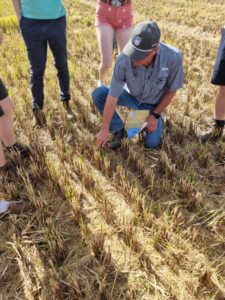
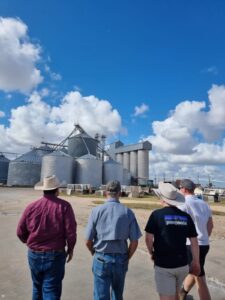
Although the family has invested heavily in rice production, and continues to do so, he is not optimistic about the future of rice farming in Texas as a result of an annual decline in water in the state, which seems to have been a theme in every enterprise we’ve seen. A reminder that climate change is challenging farmers across the globe in every form of agriculture.
Rebecca Duncan

This tour was led by company president and 5th generation farmer, Coleman Locke and his son John. Coleman and John gave us an in-depth run down of the business and its history. One thing that was of interest was that the business is split in to 8 divisions. All 8 are raising Brahman and are all branches of the family tree but work independently of each other. There is ~ 1800 cows across all divisions. Across the 8 divisions there are 15 full time family members working in the business, selling 300 bulls a year, most of which are sold privately. Each animal is branded with the company’s overall brand and then with its specific division’s brand too.
The business has been farming Brahmans since 1915 and have sold genetics to 43 different countries, with the first being sent to Australia in 1933. John stated that semen sales have dropped recently due to the increased popularity of IVF, one straw can do a lot more now a days.
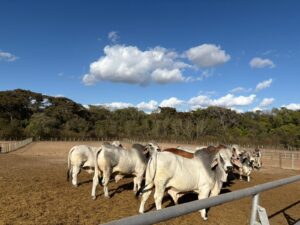
After lengthy discussions in small groups with Coleman and John we headed back to the office. Coleman stated he could have kept us there until “the day after tomorrow” talking all things Brahman and cattle but unfortunately John had a football game to go to and we had a journey to San Antonio to make. After a quick vote of thanks to let John get away, we left Hungerford and headed West to San Antonio.
Viki Johnston
Day 6- Heartbrand Beef and the Texas Agricultural Lifetime Leadership Programme

Firstly we stopped in by their distribution shop, where they pack up their Akaushi beef and ship frozen to households all over the US, this was a small facility and probably not what most of us expected, but the domestic online market is only about 2% of their meat sales. We learned here about the marbling of the meat, the muscles less used on the beast are the best marbled, for example the ribeye, strips and flat iron. The pricing of the beef is a limiting factor to the general public with the current cost of living, creating a niche market, a 14oz ribeye coming in at $55 (£41.75) or a 10oz tenderloin fillet $90 (£68.32). Although being a niche product the Heartbrand company finds that their customers tend to become loyal and prioritise the quality of their beef over price, they use social media campaigns and emailing to help the market grow. Currently they are killing 350 head a week to meet demand, these will be around 26-30 months of age and should kill out at 875-900lb hot carcass weight, they utilise all of the carcass and can reduce kill numbers to ensure they never have too much in stock. The majority of the meat is shipped out directly to a bigger distributor that sells it on to restaurants and shops.


After this we had a quick lunch stop at H.E.B. This was what can only be described as overwhelming… the sheer scale and variety of everything is amazing.
For our last visit of the day we went to the Polish Heritage Centre in Pana Maria, we were given a flying tour round the museum before having a talk from Dr Jim Mazurkiewicz. Dr Jim is the director of the Texas Agricultural Lifetime Leadership programme, which runs over two years with 24 successful applicants. It is designed to develop the candidates and push them outwith their comfort zone, with 520 hours of lecturing and training. Alongside being in charge of TALL, Dr Jim has many other roles and responsibilities, he was a great speaker to listen to and it is inspiring to listen to someone so passionate about agriculture, from grassroots to professors and everything in between. He encouraged us to grow and learn as much as we can, take every opportunity we get and continue to push the agricultural industry forwards, as he quoted us “Everybody wants the sausage but nobody wants to kill the hog”.
Beth Farmer
Days 7 & 8- The Sights of San Antonio
Saturday marked the midpoint of the trip and a chance to catch up with ourselves, spend some free time in San Antonio and enjoy some social activities. The group was keen to explore a few different authentic Texan cultural experiences whilst also catching up on some laundry.
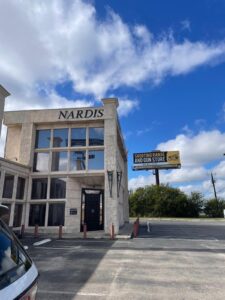
After a good breakfast and debrief on the trip so far, some of the group headed out to NARDIS Gun Club to blow off some steam. The gun culture in America is a stark contrast to back in the UK, with most citizens owning multiple firearms, and often will be concealed carrying on their person whilst out in public. It was fascinating to hear from the staff at NARDIS who were fantastic about getting us up to speed on gun safety, and the legalisation behind gun ownership and possession. A number of times it was highlighted that responsible ownership is taught from a young age and the respect towards concealed carrying and being safe when out in public is very clear. With a number of the group holding shotgun, firearms and air rifle licenses back in the UK, it was a real experience to compare this culture which seemed very far away from a ‘day at the clays’ back home. Thankfully we managed to leave the range in one piece, with a few paper targets souvenirs peppered with holes showcasing our questionable level of accuracy and grouping! A truly exhilarating experience!

In the afternoon we took the opportunity to take in another of Texas’ great cultural experiences, College Football. We couldn’t turn down the opportunity to take in a football game during our time in the US, and see how popular matches are as part of the university experience. College football is a huge industry in the states and boasts an incredibly passionate following on and off the field. Parking lots around the stadium and campus are filled with food stalls, tailgates, coolers, merchandise, and live music. The atmosphere was amazing. On the field it was the Incarnate World Cardinals hosting Southeastern Louisiana Lions. Up to the top of the bleachers, we had an excellent view of the field and spent the afternoon doing our best to work out how the game was actually played! Watching a game of football is a sensory overload, with fast paced action on the pitch, the crowd getting behind their teams, the smell of popcorn and corn dogs, cheerleaders demonstrating their routines and abilities, and the college’s marching band providing a very patriotic soundtrack. It was a spectacle and a fantastic experience to watch the game. We even managed to get some photos with players on the field after the match. They were certainly bemused by the kilts and why a bus load of Scots were there to support them!
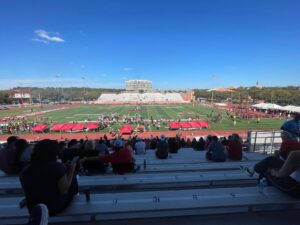
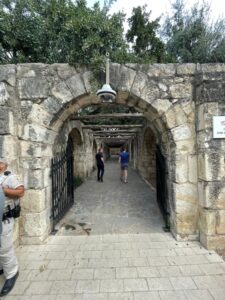
After some quick souvenir shopping and a sandwich stop, we said farewell to San Antonio and began our journey north to Stephenville, the home of Tarleton State University. On route to Stephenville, we were warmly welcomed for an al-fresco dinner and BBQ with the head of the Texas Sorghum Association Wayne Cleveland, in the gardens of his own house just outside the town of Salado. Nestled in a beautiful garden adorned with fairy lights and the gentle sound of Cicadas, Wayne and his wife Cathy laid on a tremendous feast of barbecued brisket, sausage, pork, tacos, sheet cake and much more besides, all washed down by a margarita or two! We had a quick introduction to the Texas Sorghum industry from Wayne and his colleague Ty Wilson, an interesting crop that was new to many of the group. It was a real pleasure to spend time with Wayne, Cathy and their family and receive their very kind and generous Texan hospitality.
The last bus journey of the day would then take us up to our accommodation for the next few nights, HiPoint Ranch and GKB Cattle, where we would settle in and prepare for the busy week ahead!
Fraser Graham

